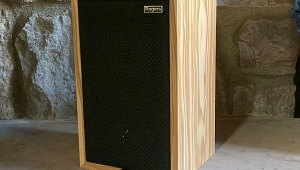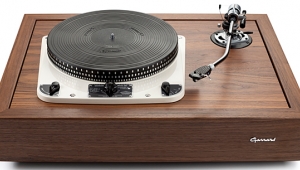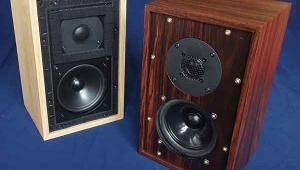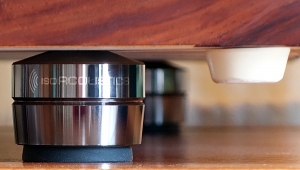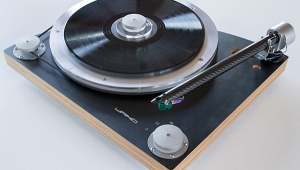| Columns Retired Columns & Blogs |
Listening #58 Page 3
The Auditorium 23 Hommage T1 sounded bigger, and the Audio Note AN-S8 sounder clearer, more present, more colorful. The Shindo Masseto's built-in trannie had a shade more texture and a more natural sense of flow, and the Auditorium 23 Standard had more character and drama. Yet the K&K never sounded deficient in any of those ways: It just sounded musical—to such a degree that, whenever I used it to play the records I love, I was able to forget about sound altogether and simply lose myself in the music.
The K&K's bass was strong enough for my tastes, and nicely detailed. It played music in a perfectly tuneful manner, with good timing and a fine, natural sense of note-to-note flow. It was neither colored nor congested. And it didn't hum. Most of all, the K&K costs only $275 and a few hours of assembly time: That really is remarkable.
Shindo Masseto stock input transformer: The phono section of the Shindo Masseto preamplifier ($11,500, reviewed in my July column) uses 6189W and 12AT7 dual-triode tubes to provide enough gain for sources that produce 3mV and up. For everything else, an extra pair of switch-selectable input jacks addresses a pair of step-up transformers: Lundahl amorphous-core units similar to the ones described above, but designed by Ken Shindo and custom-wound in Sweden. Each has a 1.1 ohm input resistance and a 508 ohm output resistance, with a tiny 11k ohm resistor added in parallel to the output pins of the trannie itself.
The Masseto's stock trannie didn't sound good when I first tried it with my Denon DL-103, but that was before I knew any of those specs—and way before I knew that Ken Shindo designed the Masseto around his own modified version of the very-low-output, very-low-impedance Ortofon SPU. No wonder...!
Since then I've used a few more reasonable cartridges with the Shindo's own trannie—including the Miyabi and Koetsu and a newly borrowed Linn Akiva—and while better performance can be had, the stock unit is good enough that the average Masseto owner could cheerily ignore other transformers if he or she wished. My Miyabi especially loved the thing: The combination had loads of texture, and enough drama to keep me happy indefinitely. Best of all, the Masseto's stock trannie was quiet in every way: no hum, and much less groove noise than average.
Tamura TKS-83 (see text for pricing): Tamura's output trannies have been associated with some of the most famous names in the single-ended-triode (SET) movement; unfortunately, given that the Japanese company does most of its business in the general electronics world, their audio products can be hard to find—and, as we went to press, it appeared than none of Tamura's many US outlets regularly carry the TKS-83 microphone/cartridge transformer. One solution is to contact the exceedingly nice people at Acoustic Dimension in the Netherlands, who will sell you a single TKS-83 trannie for €155.45, plus VAT, shipping, and insurance. You'll need two for stereo, in addition to which you'll need connectors, wire, and a chassis of some sort. View it as a challenge.
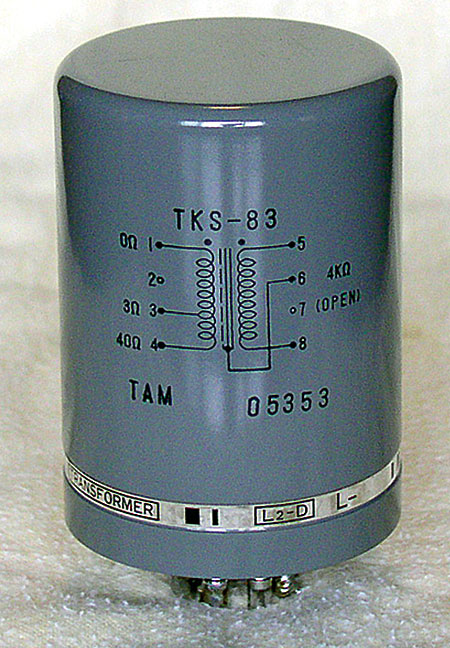
The TKS-83 is built into a gray-enameled cylinder, with a pair of threaded holes for surface mounting on its bottom flange, and electrical connections underneath. Primary taps are provided for sources of 3 and 40 ohms, and a wiring diagram is printed on the outside of the can. I measured DC resistances of 0.4 ohm for the low primary, 2.1 ohms for the high, and 857 ohms for the output.
Buying and configuring a pair of Tamuras may require more effort than usual, but the price is right—and your efforts will be rewarded with a well-textured, colorful, and remarkably natural sound overall. I've been playing around with a borrowed pair of these for four years, during most of which time I've had them wired for low-impedance cartridges. A few weeks ago I reconfigured the Tamuras for use with the high-impedance Denon and EMT cartridges, and found the same nice qualities intact. No other transformer beat the TKS-83 for its simple ability to let the music breathe in and out with a natural, easy sense of flow. As a bonus, there's something about the Tamura's sound that seems especially unperturbed by record-surface noise.
On the downside, the TKS-83 lacks a bit of drama when compared with the Audio Note AN-S8 or either of the Auditorium 23 trannies—and lacks bass extension and sheer whomp compared to the Hommage. Still, it's a lovely, organic-sounding product: a fine all-arounder and a very good deal for the adventurous audiophile.
VAS MC-One ($750): This is the first step-up transformer from VAS Industries, which distributes the popular Cayin and VAS tube amplifiers. Their website describes the Chinese-made MC-One as a "tube" product in its own right, but that seems more a function of translation error than of any intent to deceive. In any event, I took it as one more link in the chain of subconscious association between tubes and trannies, which are good and good, respectively.
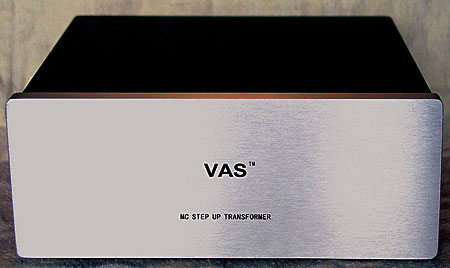
The MC-One is built into a larger-than-usual chassis as these things go, and seems more or less impenetrable. Suffice it to say, the MC-One is both handsome and rugged: Perhaps Chris Matthews will wonder if it smells like cigar smoke and Aqua Velva. There are two sets of gold-plated input jacks, labeled Low and High; remarkably, their resistances were 43 and 143 ohms, respectively; I measured a resistance of 539 ohms at the gold-plated output jacks.
The low-impedance inputs actually sounded fine with higher-impedance cartridges such as the Denon: Bass notes were commendably clear, as in the double-guitar intro to Willie Nelson's "Funny How Time Slips Away," from Hello Walls (Pickwick SPC 3584); and the spatial presentation on stereo recordings was fine, if somewhat lacking in scale compared to other trannies. Hum was nonexistent, even without a ground connection.
If not for the K&K and Tamura alternatives—notwithstanding the challenges of building the former and finding the latter—the VAS MC-One would get high marks for value. But the Tamura TKS-83 was a bit more engaging than the VAS with the Denon cartridge, and while I can't say for sure how the K&K would compare—I haven't yet found the time to rewire it for use with the Denon—in its favor is its much lower price. On a similar note, the Auditorium 23 costs only $245 more, yet was significantly more open, dramatic, and involving.
I still haven't found a cartridge that locks in with the high-impedance inputs of the MC-One, but I'm very much open to suggestion...
...And that leads me to an important parting observation: Remember that every pairing of an MC cartridge model and a given step-up transformer primary will perform differently—predictably, electrically, measurably, and audibly so—from every other pairing. While it's possible for a step-up transformer with multiple sets of primaries (or primary taps) to perform well with a number of different cartridges and cartridge designs, that number is unlikely to be very big—and fixed-primary transformers can be counted on to work really well with, at most, only a handful of different cartridge models. That fact—well accounted for by both the science and the art of transformer design—is no shortcoming. For that reason, there can never be a "best" step-up transformer; the adventurous consumer must trust his or her own ears, guided, one hopes, by a really knowledgeable dealer with a liberal—and I do mean liberal—home trial policy.
- Log in or register to post comments


